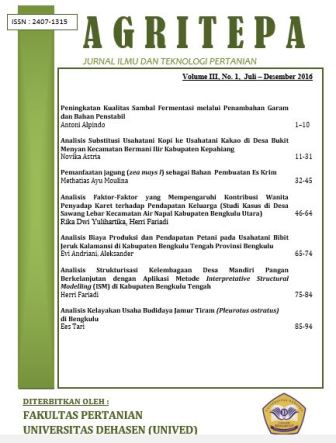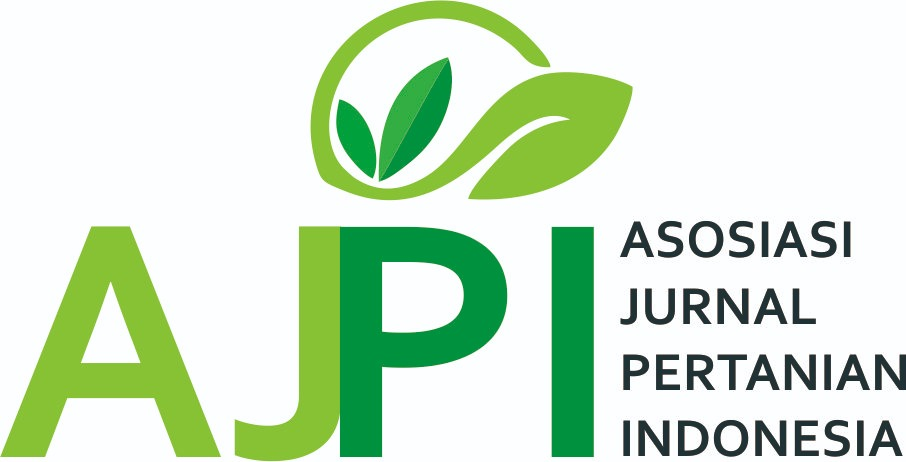Effect of Various Methods of Processing Curly Red Chilli (Capsicum annum L.) on the Physicochemical and Organoleptic Characteristics of Coconut Nira Soy Sauce
Abstract
Soy sauce is a liquid product derived from fermented soybeans or soybean meal plus sugar with or without the addition of other food ingredients. Soy sauce is usually made from soybeans, but apart from soybeans, soy sauce can be made with coconut sap. Previously, research on coconut sap soy sauce had been conducted, but the results showed that the panelists' preference for coconut sap soy sauce was still low. In this study, the addition of curly red chili with various processing methods and spices was thought to increase the panelists' preference for coconut sap soy sauce. This study aimed to examine the physicochemical and organoleptic characteristics of coconut sap soy sauce with the addition of curly red chili with four processing methods. The chili processing methods used were coarsely ground chilies, finely ground chilies, dried chili powder, and chili extracts. The research stages include the process of making coconut sap soy sauce, organoleptic tests, viscosity tests, acidity tests (pH), and sucrose tests. ANOVA (Analysis of Variance) and SPSS applications were used to analyze the test data. If significant results are obtained, the analysis is continued with Duncan's Multiple Range Test (DMRT) with a significance level of 5%. Based on the test results, the addition of various chili processing methods significantly affected the degree of acidity (pH), viscosity, sucrose content, hedonic color, hedonic viscosity, and hedonic spiciness. However, the effect is not significant on the hedonic aroma. The coconut sap soy sauce with chili extract obtained the highest score for the ranking test assessment.
Downloads
References
A. E. Prihatiningrum and dan B. Findurina, “Pemanfaatan Ampas Tahu Menjadi Kecap: Kajian Proporsi Filtrat Ampas Tahu Dengan Gula Kelapa Terhadap Kualitas Kecap,” vol. 333.
A. Ikhsani and W. Susanto, “Rawit Serta Konsentrasi Ekstrak Rosella Merah Terhadap Sifat Fisik Kimia Organoleptik Saus Labu Kuning Pedas,” J. Pangan dan Agroindustri, vol. 3, no. 2, pp. 499–510, 2014, [Online]. Available: http://jpa.ub.ac.id/index.php/jpa/article/view/168.
A. Iskandar, “Karakteristik Nira Kelapa Fermentasi dengan Metoda Fermentasi Moromi,” vol. 30, no. 2, pp. 244–255, 2020.
A. N. Suseno and R. S. Prawiradilaga, “Hubungan Kebiasaan Mengonsumsi Makanan Pedas dengan Indeks Massa Tubuh pada Wanita Dewasa di Kota Tasikmalaya pada Tahun,” pp. 145–152, 2021.
Badan Standardisasi Nasional, “SNI 3543.1:2013 Kecap Kedelai - Bagian 1 : Manis,” pp. 1–28, 2013.
D. A. Cahyani and A. A. Suhastyo, “Pengaruh bahan dan waktu perendaman terhadap tingkat kepedasan bubuk cabai merah,” Pros. Semin. Nas. Kahuripan I, p. 135, 2020.
E. Ernasari, P. Patang, and K. Kadirman, “Pemanfaatan Sari Tebu (Saccharum Oficinarum) dan Lama Fermentasi Kacang Tunggak Terhadap Kualitas Kecap Manis Kacang Tunggak (Vigna Unguiculata),” J. Pendidik. Teknol. Pertan., vol. 4, no. 2, p. 88, 2018, doi: 10.26858/jptp.v4i2.6616.
Haerani and Hamdana, “Pengembangan Kecap dari Air Kelapa,” Pros. Semin. Nas. Himpun. Sarj. Ilmu-ilmu Sos., pp. 335–348, 2016.
I. Safitri and S. Putri, “Pengaruh Penambahan Berbagai Jenis Cabai (Capsicum Annum L) terhadap Kualitas Organoleptik dan Kandungan Vitamin C Manisan Basah Labu Siam (Sechium Edule),” J. Kebidanan, vol. 3, no. 1, pp. 43–49, 2017.
J. H. Mandei and A. M. Nuryadi, “Pengaruh pH sari buah pala terhadap kandungan gula reduksi dan tekstur permen keras,” J. Penelit. Teknol. Ind., vol. 11, no. 1, pp. 19–30, 2019.
Kurniati, E dan Huy V. T, “Analisis pengaruh pH dan suhu pada desinfeksi air menggunakan microbubbble dan karbondioksida bertekanan,” Journal of Natural Resources and Enviromental Management Vol 10. pp. 145–152, 2020. http://dx.doi.org/10.29244/jpsl.10.2.247-256
Lumbantoruan P. dan Yulianti E, “Pengaruh Suhu Terhadap Viskositas Minyak Pelumas,”. Sainmatika: Jurnal Ilmiah Matematika dan Ilmu Pengetahuan Alam. pp. 26-34, 2016.
M. E. S. Ledo, “Kandungan Protein Kecap Nira Lontar dengan Variasi Konsentrasi Tepung Tempe,” Biota J. Ilm. Ilmu-Ilmu Hayati, vol. 5, no. 2, pp. 130–135, 2021, doi: 10.24002/biota.v5i2.2970.
N. Aini, P. Hariyadi, T.-R. Muchtadi, and N. Andarwulan, “Hubungan antara waktu fermentasi grits jagung dengan sifat gelatinisasi tepung jagung putih yang dipengaruhi ukuran partikel,” J. Teknol. dan Ind. Pangan, vol. XXI, no. 1, pp. 18–24, 2010.
N. O. Saputri, “Uji Mutu Fisikokimia dan Organoleptik Saus Kecap Nira Kelapa (Studi Kasus: Desa Karang Anyar, Lampung Selatan),” 2022.
Raisantara Pratami Putri, “Pembuatan Daging Analog Berbahan Baku Tepung Kedelai Lokal Unggul (Varietas Anjasmoro) dengan Variasi Penambahan Gluten dan Isolat Protein Kedelai,” Digit. Repos. Univ. Jember, no. September 2019, pp. 2019–2022, 2021.
R. F. Pratiwi, R. Utami, and E. Nurhartadi, “Pengaruh Lama Fermentasi Moromi Terhadap Viskositas, Kaar Protein Terlarut, Aktivitas Antioksidan, dan Sensori Kecap Bungkil Wijen Putih Sangrai dan Non Sangrai,” vol. V, no. 2, 2012.
Y. R. Meutia, “Standardisasi Produk Kecap Kedelai Manis Sebagai Produk Khas Indonesia,” J. Stand., vol. 17, no. 2, p. 147, 2016, doi: 10.31153/js.v17i2.314.
Copyright (c) 2023 Muhammad Rizky Ramanda, Alexandra T. Putri, Amalia Wahyuningtyas

This work is licensed under a Creative Commons Attribution-ShareAlike 4.0 International License.
Author retains the copyright and grants the journal the right of first publication of the work simultaneously licensed under the Creative Commons Attribution-ShareAlike 4.0 License that allows others to share the work with an acknowledgement of the work's authorship and initial publication in this journal













